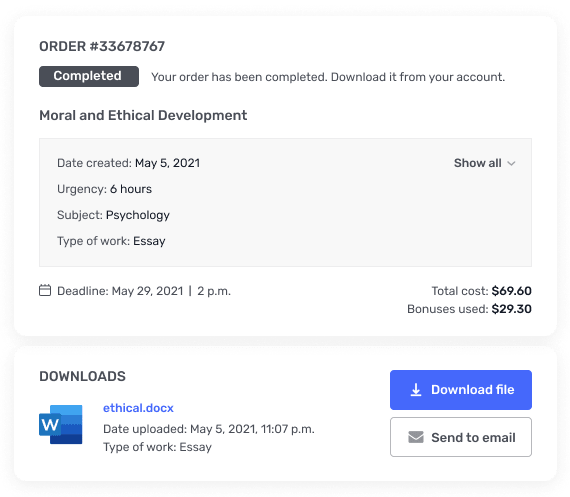online exam
Part 1 of 2 – 50.0/
50.0 Points
Question 1 of 40
2.5/ 2.5 Points
Because financial ratios can vary across industries, it is
__________ these ratios by industry.
A. not necessary to
study
B. unimportant to
benchmark
C. important to
benchmark
D. futile to examine
Question 2 of 40
2.5/ 2.5 Points
Comparing two companies using __________ may point out
differences in management styles.
A. common-size
financial statements
B. sales growth
C. historical share
prices
D. earnings per
share
Question 3 of 40
2.5/ 2.5 Points
Which of the statements below is true?
A. Inventory
turnover is cost of goods sold divided by accounts receivables.
B. Receivables
turnover is accounts receivable divided by sales.
C. Total asset
turnover is profits divided by total assets.
D. A higher
inventory turnover ratio signifies that inventory is moving faster.
Question 4 of 40
2.5/ 2.5 Points
To convert an income statement into a common-size income
statement, we restate all the numbers as percentages of:
A. total revenues.
B. cost of goods
sold.
C. net income.
D. total assets.
Question 5 of 40
2.5/ 2.5 Points
Income statements are often prepared:
A. monthly for
external use and quarterly for internal reporting.
B. annually for
internal use and quarterly for external reporting.
C. monthly for
internal use and quarterly for external reporting.
D. monthly for
internal use and annually for external reporting.
Question 6 of 40
2.5/ 2.5 Points
Which of the following statements is true about
benchmarking?
A. It compares a
company’s current performance against its own previous performance.
B. It compares a
company’s performance against that of its competitors.
C. It provides a
standard of comparison for financial measurement.
D. All of the above
statements are true about benchmarking.
Question 7 of 40
2.5/ 2.5 Points
Earnings per share is the:
A. price per share
divided by the earnings per share.
B. net income
divided by the number of outstanding shares.
C. market value per
shares divided by the book value per share.
D. P/E ratio divided
by the earnings growth rate times 100.
Question 8 of 40
2.5/ 2.5 Points
__________ is the listing of all assets and all claims
against the assets of a company.
A. The Balance Sheet
or Statement of Financial Position
B. Income Statement
C. The Sources and
Uses of Cash
D. All of the above
Question 9 of 40
2.5/ 2.5 Points
Which of the statements below is false?
A. The acid ratio
test equals current assets minus inventories divided by current liabilities.
B. Examples of
liquidity ratios include the current ratio, the cash coverage ratio, and the
quick ratio.
C. The current ratio
is current assets divided by current liabilities.
D. Inventory
turnover equals cost of goods sold divided by inventory.
Question 10 of 40
2.5/ 2.5 Points
Financial ratios __________ industries.
A. can vary across
B. are unchanging
across
C. are homogeneous
across
D. are always
different across
Question 11 of 40
2.5/ 2.5 Points
Which of the following statements is true?
A. The current ratio
is current assets divided by current liabilities.
B. Total asset
turnover is net income divided by total assets.
C. The cash coverage
ratio equals cash divided by current liabilities.
D. The quick ratio
equals current assets – current liabilities divided by current liabilities.
Question 12 of 40
2.5/ 2.5 Points
__________ can be helpful for managers to understand
short-term cash obligations.
A. Profitability
ratios
B. Asset management
ratios
C. Solvency ratios
D. Liquidity ratios
Question 13 of 40
2.5/ 2.5 Points
Total current liabilities are $100,000 and total owners’
equity is
$2,000,000. What are total assets?
A. We need to know
retained earnings before we can compute total assets.
B. We need more
information on long-term liabilities before we can compute
total assets.
C. $2,000,000
D. $2,100,000
Question 14 of 40
2.5/ 2.5 Points
Once financial statements are made public, the external
analysis of the company begins by:
A. financial
analysts.
B. certified tax
planners.
C. the advertising
department.
D. All of the above
Question 15 of 40
2.5/ 2.5 Points
Orange Electronics Inc. has a profitability ratio of 0.14,
an asset turnover ratio of 1.7, a debt to equity ratio of 0.60, and a total
asset to equity ratio of 1.60. What is the firm’s ROE?
A. 14.28%
B. 22.85%
C. 38.08%
D. 41.76%
Question 16 of 40
2.5/ 2.5 Points
Which industry has the lowest average industry
debt-to-equity ratio?
A. Auto
B. Retail
C. Oil and gas
D. Airlines
Question 17 of 40
2.5/ 2.5 Points
EBIT is $10,000 and interest expense is $4,000. If the tax
rate is 30%, what is the net income?
A. $3,800
B. $4,200
C. $5,200
D. $8,400
Question 18 of 40
2.5/ 2.5 Points
Financial analysts provide recommendations to their clients
about what company:
A. to buy.
B. to invest in.
C. to sell or
divest.
D. All of the above
Question 19 of 40
2.5/ 2.5 Points
Profit margin is equal to:
A. net income
divided by total assets.
B. net income
divided by total owners’ equity.
C. net income
divided by sales.
D. None of the above
Question 20 of 40
2.5/ 2.5 Points
Which of the statements below is FALSE?
A. When the current
ratio is greater than 1, we are also saying that net working capital is
positive as current assets are greater than current liabilities.
B. Financial
leverage ratios deal with long-term solvency and the use of debt as a financing
tool.
C. The debt ratio is
total assets minus total equity divided by equity.
D. Times interest
earned equals EBIT divided by interest expense.
Part 2 of 2 – 30.0/
50.0 Points
Question 21 of 40
2.5/ 2.5 Points
Which of the following statements is FALSE about sole
proprietorships?
A. They mix the
assets of the company with the personal assets of the owner.
B. The owner
receives some, but not all, of the profits.
C. The limitation of
capital may constrain growth.
D. The owner makes all
decisions.
Question 22 of 40
0.0/ 2.5 Points
U.S. Small Business Administration (SBA) guarantee loans
have an interest rate that is on average:
A. the same as
current market rates on business loans.
B. lower than
current market rates on business loans.
C. higher than
current market rates on business loans.
D. the same as
mortgage loans.
Question 23 of 40
2.5/ 2.5 Points
If you go to your bank and it grants you a lump sum loan
today that requires monthly payments for a fixed period of time to repay the
borrowed money, you have most likely received a:
A. discount loan.
B. line of credit.
C. straight loan
with a preset payment schedule.
D. compensating
balance loan.
Question 24 of 40
0.0/ 2.5 Points
Commercial paper and bankers’ acceptances are two forms of
corporate financing typically undertaken by:
A. start-up firms.
B. mature firms.
C. sole proprietorships.
D. All of the above
Question 25 of 40
2.5/ 2.5 Points
Commercial paper has a maturity of:
A. less than 270
days.
B. nine to eighteen
months.
C. greater than one
year.
D. three to five
years.
Question 26 of 40
0.0/ 2.5 Points
Starting a business with __________ is by far the most
common start-up financing.
A. bonds and equity
B. personal and
family funds
C. bank loans
D. venture capital
Question 27 of 40
0.0/ 2.5 Points
Typical U.S. Small Business Administration (SBA) guarantee
loans carry an interest rate equal to:
A. the prime rate.
B. current market
rates.
C. the prime rate
plus a 1% default risk premium.
D. the prime rate
less 1% due to the SBA guarantee.
Question 28 of 40
2.5/ 2.5 Points
With a line of credit, the bank is compensated:
A. based on the
outstanding balance of the loan.
B. based on the
principal value of the credit line.
C. exclusively with
a fixed annual payment.
D. based on a fixed
interest rate tied to the T-bill rate.
Question 29 of 40
0.0/ 2.5 Points
Which of the following answer choices is more characteristic
of a venture capitalist than an angel investor?
A. Usually
individuals or groups; invests own money; early stages of the business
B. Usually corporate
entities; often tied to individual or group expertise; early stages of the
business
C. Usually
individuals or groups; pooled money from range of investors; all stages of the
business
D. Usually corporate
entities; pooled money from range of investors; all stages of the business
Question 30 of 40
2.5/ 2.5 Points
What is the street name for the advertisement issued during
the period of time when a firm is waiting for approval from the SEC to issue
new securities? This advertisement typically contains the name of the issuing
firm and the list of investment bankers involved in underwriting and marketing
the new issue.
A. Indenture
B. Tombstone
C. Red herring
D. Letter of comment
Question 31 of 40
0.0/ 2.5 Points
A __________ type of loan is similar to a line of credit.
However, even though only a portion of the loan is available to the borrower,
interest is paid on the entire face value of the loan.
A. line of credit
B. compensating
balance
C. straight loan
with preset payment schedule
D. discount
Question 32 of 40
0.0/ 2.5 Points
By making a __________, the investment banker agrees to buy
an entire issue of new securities from a firm from a firm followed by resale of
the securities to the public.
A. firm commitment
B. best-efforts
C. IPO
D. due diligence
Question 33 of 40
2.5/ 2.5 Points
Bonds may be issued through either a __________ or a
__________.
A. private auction;
federal auction
B. state agency;
federal agency
C. public auction;
private placement
D. None of the above
Question 34 of 40
2.5/ 2.5 Points
The __________ is the formal contract for the bond between
the issuing company and the buyer.
A. debenture
B. sinking fund
C. indenture
D. prospectus
Question 35 of 40
0.0/ 2.5 Points
If the U.S. Small Business Administration (SBA) makes a loan
guarantee, the guarantee is only __________. If the original borrower defaults,
the government will repay the obligation up to the __________.
A. to the borrower;
loan balance
B. to the public at
large; percentage of the SBA guarantee
C. to the lending
institution; percentage of the SBA guarantee
D. to the lending
institution; loan balance
Question 36 of 40
2.5/ 2.5 Points
In the life cycle of a business, a stable life cycle stage
is most closely identified with:
A. old age.
B. youth.
C. maturity.
D. infancy.
Question 37 of 40
2.5/ 2.5 Points
A letter of credit or line of credit is a preapproved
borrowing amount that works much like a:
A. premium loan.
B. discount loan.
C. syndicated loan.
D. credit card.
Question 38 of 40
2.5/ 2.5 Points
Syndicated loans are:
A. loans where
multiple banks join together to make a loan to a single company.
B. loans made to
television stations to purchase re-runs.
C. loans where one
bank makes several loans to firms in the same industry in an effort to
diversify the bank’s loan portfolio.
D. loans bought by
other banks that have unused funds available for loans.
Question 39 of 40
2.5/ 2.5 Points
The two chapters for commercial businesses to handle
financial difficulties under the Bankruptcy Reform Act of 1978 are:
A. Chapters 7 and
11.
B. Chapters 7 and
13.
C. Chapters 9 and
11.
D. Chapters 11 and
13.
Question 40 of 40
2.5/ 2.5 Points
A major issue with venture capitalists and angel investors
is the rate at which their funds will be used up. This is called the:
A. consumption or
constriction rate.
B. burn rate or
bleed rate.
C. IV rate.
D. depreciation
rate.




